Avenanthramide Improves Colonic Damage Induced by Food Allergies in Mice through Altering Gut Microbiota and Regulating Hsp70-NF-κB Signaling
Abstract
1. Introduction
2. Materials and Methods
2.1. Animal Model Experiments
2.2. Determination of Cytokines and Tight Junction Proteins
2.3. Western Blot
2.4. Gut Microbiota Analysis
2.5. Short-Chain Fatty Acid Detection
2.6. Statistic Analysis
3. Results
3.1. Effect of AVA on the Colonic Barrier Damage Induced by FA in Exp. 1
3.2. Effect of AVA on the Allergic Inflammatory Response of Colon in Exp. 1
3.3. Effect of AVA on the Hsp70-NF-kB Signaling in Exp. 1
3.4. Effect of Hsp70 Inhibition on the Role of AVA in Colonic Damage Induced by OVA in Exp. 2
3.5. Effect of AVA on Alteration of Gut Microbes in Exp. 2
3.6. Effect of AVA on Short-Chain Fatty Acids Content in Exp. 2
3.7. Correlation between Gut Microbes and Short-Chain Fatty Acids in Exp. 2
4. Discussion
5. Conclusions
Author Contributions
Funding
Institutional Review Board Statement
Conflicts of Interest
References
- De Martinis, M.; Sirufo, M.M.; Suppa, M.; Ginaldi, L. New perspectives in food allergy. Int. J. Mol. Sci. 2020, 21, 1474. [Google Scholar] [CrossRef] [PubMed]
- Heine, R.G. Food allergy prevention and treatment by targeted nutrition. Ann. Nutr. Metab. 2018, 72, 33–45. [Google Scholar] [CrossRef] [PubMed]
- Honda, K.; Littman, D.R. The microbiota in adaptive immune homeostasis and disease. Nature 2016, 535, 75–84. [Google Scholar] [CrossRef] [PubMed]
- Mowat, A.M. Anatomical basis of tolerance and immunity to intestinal antigens. Nat. Rev. Immunol. 2003, 3, 331–341. [Google Scholar] [CrossRef]
- Stephen-Victor, E.; Crestani, E.; Chatila, T.A. Dietary and microbial determinants in food allergy. Immunity 2020, 53, 277–289. [Google Scholar] [CrossRef]
- Niewiem, M.; Grzybowska-Chlebowczyk, U. Intestinal barrier permeability in allergic diseases. Nutrients 2022, 14, 1893. [Google Scholar] [CrossRef]
- Ali, A.; Tan, H.; Kaiko, G.E. Role of the intestinal epithelium and its interaction with the microbiota in food allergy. Front. Immunol. 2020, 11, 604054. [Google Scholar] [CrossRef]
- Kataoka, K. The intestinal microbiota and its role in human health and disease. J. Med. Investig. 2016, 63, 27–37. [Google Scholar] [CrossRef]
- Iweala, O.I.; Nagler, C.R. The microbiome and food allergy. Annu. Rev. Immunol. 2019, 37, 377–403. [Google Scholar] [CrossRef]
- Kelly, C.J.; Zheng, L.; Campbell, E.L.; Saeedi, B.; Scholz, C.C.; Bayless, A.J.; Wilson, K.E.; Glover, L.E.; Kominsky, D.J.; Magnuson, A.; et al. Crosstalk between microbiota derived short-chain fatty acids and intestinal epithelial HIF augments tissue barrier function. Cell Host Microbe 2015, 17, 662–671. [Google Scholar] [CrossRef]
- Kim, C.H.; Park, J.; Kim, M. Gut microbiota-derived short-chain fatty acids, T cells, and inflammation. Immune Netw. 2014, 14, 277–288. [Google Scholar] [CrossRef] [PubMed]
- Sun, J.; Wu, Q.; Sun, H.; Qiao, Y.L. Inhibition of histone deacetylase by butyrate protects rat liver from ischemic reperfusion injury. Int. J. Mol. Sci. 2014, 15, 21069–21079. [Google Scholar] [CrossRef] [PubMed]
- Lyu, Q.; Wawrzyniuk, M.; Rutten, V.P.M.G.; van Eden, W.; Sijts, A.J.A.M.; Broere, F. Hsp70 and NF-kB mediated control of innate inflammatory responses in a canine macrophage cell line. Int. J. Mol. Sci. 2020, 21, 6464. [Google Scholar] [CrossRef] [PubMed]
- Rodríguez-Daza, M.C.; Pulido-Mateos, E.C.; Lupien-Meilleur, J.; Guyonnet, D.; Desjardins, Y.; Roy, D. Polyphenol-mediated gut microbiota modulation: Toward prebiotics and further. Front. Nutr. 2021, 8, 689456. [Google Scholar] [CrossRef] [PubMed]
- Collins, F.W. Oat phenolics: Avenanthramides, novel substituted N-Cinnamoylanthranilate alkaloids from oat groats and hulls. J. Agric. Food Chem. 1989, 37, 60–66. [Google Scholar] [CrossRef]
- Escobedo-Flores, Y.; Chavez-Flores, D.; Salmeron, I.; Molina-Guerrero, C.; Perez-Vega, S. Optimization of supercritical fluid extraction of polyphenols from oats (Avena sativa L.) and their antioxidant activities. J. Cereal. Sci. 2018, 80, 198–204. [Google Scholar] [CrossRef]
- Dhakal, H.; Yang, E.J.; Lee, S.; Kim, M.J.; Baek, M.C.; Lee, B.; Park, P.H.; Kwon, T.K.; Khang, D.; Song, K.S.; et al. Avenanthramide C from germinated oats exhibits anti-allergic inflammatory effects in mast cells. Sci. Rep. 2019, 9, 6884. [Google Scholar] [CrossRef]
- Chen, C.Y.; Milbury, P.E.; Collins, F.W.; Blumberg, J.B. Avenanthramides are bioavailable and have antioxidant activity in humans after acute consumption of an enriched mixture from oats. J. Nutr. 2007, 137, 1375–1382. [Google Scholar] [CrossRef]
- Liu, P.; Liu, T.; Zhang, M.; Mo, R.; Zhou, W.; Li, D.; Wu, Y. Effects of avenanthramide on the small intestinal damage through Hsp70-NF-κB signaling in an ovalbumin-induced food allergy model. Int. J. Mol. Sci. 2022, 23, 15229. [Google Scholar] [CrossRef]
- Williamson, G.; Clifford, M.N. Role of the small intestine, colon and microbiota in determining the metabolic fate of polyphenols. Biochem. Pharmacol. 2017, 139, 24–39. [Google Scholar] [CrossRef]
- Gowd, V.; Karim, N.; Shishir, M.R.I.; Xie, L.H.; Chen, W. Dietary polyphenols to combat the metabolic diseases via altering gut microbiota. Trends Food Sci. Tech. 2019, 93, 81–93. [Google Scholar] [CrossRef]
- Ko, S.K.; Kim, J.; Na, D.C.; Park, S.; Park, S.H.; Hyun, J.Y.; Baek, K.H.; Kim, N.D.; Kim, N.K.; Park, Y.N.; et al. A small molecule inhibitor of ATPase activity of Hsp70 induces apoptosis and has antitumor activities. Chem. Biol. 2015, 22, 391–403. [Google Scholar] [CrossRef] [PubMed]
- Wu, Y.; Mo, R.; Zhang, M.; Zhou, W.; Li, D. Grape seed proanthocyanidin alleviates intestinal inflammation through gut microbiota-bile acid crosstalk in mice. Front. Nutr. 2022, 8, 786682. [Google Scholar] [CrossRef]
- Zhang, D.; Liu, H.; Wang, S.; Zhang, W.; Wang, J.; Tian, H.; Wang, Y.; Ji, H. Fecal microbiota and its correlation with fatty acids and free amino acids metabolism in piglets after a Lactobacillus strain oral administration. Front. Microbiol. 2019, 10, 785. [Google Scholar] [CrossRef] [PubMed]
- Sur, R.; Nigam, A.; Grote, D.; Liebel, F.; Southall, M.D. Avenanthramides, polyphenols from oats, exhibit anti- inflammatory and anti-itch activity. Arch. Dermatol. Res. 2008, 300, 569–574. [Google Scholar] [CrossRef]
- Khodoun, M.V.; Tomar, S.; Tocker, J.E.; Wang, Y.H.; Finkelman, F.D. Prevention of food allergy development and suppression of established food allergy by neutralization of thymic stromal lymphopoietin, IL-25, and IL-33. J. Allergy Clin. Immunol. 2018, 141, 171–179. [Google Scholar] [CrossRef] [PubMed]
- Guo, W.; Nie, L.; Wu, D.; Wise, M.L.; Collins, F.W.; Meydani, S.N.; Meydani, M. Avenanthramides inhibit proliferation of human colon cancer cell lines in vitro. Nutr. Cancer 2010, 62, 1007–1016. [Google Scholar] [CrossRef] [PubMed]
- Geremia, A.; Biancheri, P.; Allan, P.; Corazza, G.R.; Di Sabatino, A. Innate and adaptive immunity in inflammatory bowel disease. Autoimmun. Rev. 2014, 13, 3–10. [Google Scholar] [CrossRef] [PubMed]
- Chinthrajah, R.S.; Hernandez, J.D.; Boyd, S.D.; Galli, S.J.; Nadeau, K.C. Molecular and cellular mechanisms of food allergy and food tolerance. J. Allergy Clin. Immunol. 2016, 137, 984–997. [Google Scholar] [CrossRef]
- Chambers, S.J.; Bertelli, E.; Winterbone, M.S.; Regoli, M.; Man, A.L.; Nicoletti, C. Adoptive transfer of dendritic cells from allergic mice induces specific immunoglobulin E antibody in naïve recipients in absence of antigen challenge without altering the T helper 1/T helper 2 balance. Immunology 2004, 112, 72–79. [Google Scholar] [CrossRef]
- Romagnani, S. Immunologic influences on allergy and the TH1/TH2 balance. J. Allergy Clin. Immunol. 2004, 113, 395–400. [Google Scholar] [CrossRef]
- Sampson, H.A.; O’Mahony, L.; Burks, A.W.; Plaut, M.; Lack, G.; Akdis, C.A. Mechanisms of food allergy. J. Allergy Clin. Immunol. 2018, 141, 11–19. [Google Scholar] [CrossRef]
- Jiménez, M.; Muñoz, F.C.; Cervantes-García, D.; Cervantes, M.M.; Hernández-Mercado, A.; Barrón-García, B.; Moreno Hernández-Duque, J.L.; Rodríguez-Carlos, A.; Rivas-Santiago, B.; Salinas, E. Protective effect of Glycomacropeptide on food allergy with gastrointestinal manifestations in a rat model through down-regulation of Type 2 immune response. Nutrients 2020, 12, 2942. [Google Scholar]
- Arbizu, S.; Chew, B.; Mertens-Talcott, S.U.; Noratto, G. Commercial whey products promote intestinal barrier function with glycomacropeptide enhanced activity in downregulating bacterial endotoxin lipopolysaccharides (LPS)-induces inflammation in vitro. Food Funct. 2020, 11, 5842–5852. [Google Scholar] [CrossRef] [PubMed]
- Bemark, M.; Angeletti, D. Know your enemy or find your friend? Induction of IgA at mucosal surfaces. Immunol. Rev. 2021, 303, 83–102. [Google Scholar] [CrossRef]
- Konkel, J.E.; Chen, W.J. Balancing acts: The role of TGF-β in the mucosal immune system. Trends Mol. Med. 2011, 17, 668–676. [Google Scholar] [CrossRef] [PubMed]
- Otani, T.; Furuse, M. Tight junction structure and function revisited. Trends Cell Biol. 2020, 30, 805–817. [Google Scholar] [CrossRef]
- Shin, N.R.; Whon, T.W.; Bae, J.W. Proteobacteria: Microbial signature of dysbiosis in gut microbiota. Trends Biotechnol. 2015, 33, 496–503. [Google Scholar] [CrossRef]
- Yu, X.; Wu, Z.; Song, Z.; Zhang, H.; Zhan, J.; Yu, H.; Huang, H.; Yang, B.; Xie, L.; Dai, X.; et al. Single-anastomosis duodenal jejunal bypass improve glucose metabolism by regulating gut microbiota and short-chain fatty acids in Goto-Kakisaki rats. Front. Microbiol. 2020, 11, 273. [Google Scholar] [CrossRef]
- Koh, A.; De Vadder, F.; Kovatcheva-Datchary, P.; Bäckhed, F. From dietary fiber to host physiology: Short-chain fatty acids as key bacterial metabolites. Cell 2016, 165, 1332–1345. [Google Scholar] [CrossRef]
- Louis, P.; Flint, H.J. Formation of propionate and butyrate by the human colonic microbiota. Environ. Microbiol. 2017, 19, 29–41. [Google Scholar] [CrossRef]
- Smith, B.J.; Miller, R.A.; Schmidt, T.M. Muribaculaceae genomes assembled from metagenomes suggest genetic drivers of differential response to acarbose treatment in mice. mSphere 2021, 6, e0085121. [Google Scholar] [CrossRef]
- Liu, H.; Liao, C.; Wu, L.; Tang, J.; Chen, J.; Lei, C.; Zheng, L.; Zhang, C.; Liu, Y.Y.; Xavier, J.; et al. Ecological dynamics of the gut microbiome in response to dietary fiber. ISME J. 2022, 16, 2040–2055. [Google Scholar] [CrossRef] [PubMed]
- Li, H.; Xiang, Y.; Zhu, Z.; Wang, W.; Jiang, Z.; Zhao, M.; Cheng, S.; Pan, F.; Liu, D.; Ho, R.C.M.; et al. Rifaximin-mediated gut microbiota regulation modulates the function of microglia and protects against CUMS-induced depression-like behaviors in adolescent rat. J. Neuroinflammat. 2021, 18, 254. [Google Scholar] [CrossRef] [PubMed]
- Keshavarzian, A.; Green, S.J.; Engen, P.A.; Voigt, R.M.; Naqib, A.; Forsyth, C.B.; Mutlu, E.; Shannon, K.M. Colonic bacterial composition in parkinson’s disease. Mov. Disord. 2015, 30, 1351–1360. [Google Scholar] [CrossRef] [PubMed]
- Zhong, Y.B.; Kang, Z.P.; Wang, M.X.; Long, J.; Wang, H.Y.; Huang, J.Q.; Wei, S.Y.; Zhou, W.; Zhao, H.M.; Liu, D.Y. Curcumin ameliorated dextran sulfate sodium-induced colitis via regulating the homeostasis of DCs and Treg and improving the composition of the gut microbiota. J. Funct. Foods 2021, 86, 104716. [Google Scholar] [CrossRef]
- Darakhshan, S.; Pour, A.B. Tranilast: A review of its therapeutic applications. Pharmacol. Res. 2015, 91, 15–28. [Google Scholar] [CrossRef]
- Morgan, M.J.; Liu, Z.G. Crosstalk of reactive oxygen species and NF-κB signaling. Cell Res. 2011, 21, 103–115. [Google Scholar] [CrossRef]
- Borges, T.J.; Wieten, L.; van Herwijnen, M.J.; Broere, F.; van der Zee, R.; Bonorino, C.; van Eden, W. The anti-inflammatory mechanisms of Hsp70. Front. Immunol. 2012, 3, 95. [Google Scholar] [CrossRef]
- Yuan, Z.Q.; Zhang, Y.; Li, X.L.; Peng, Y.Z.; Huang, Y.S.; Yang, Z.C. HSP70 protects intestinal epithelial cells from hypoxia/reoxygenation injury via a mechanism that involves the mitochondrial pathways. Eur. J. Pharmacol. 2010, 643, 282–288. [Google Scholar] [CrossRef]
- Sziksz, E.; Veres, G.; Vannay, A.; Prókai, A.; Gál, K.; Onody, A.; Korponay-Szabó, I.R.; Reusz, G.; Szabó, A.; Tulassay, T.; et al. Increased heat shock protein 72 expression in celiac disease. J. Pediatr. Gastroenterol. Nutr. 2010, 51, 573–578. [Google Scholar] [CrossRef] [PubMed]
- Buchman, T.G.; Abello, P.A.; Smith, E.H.; Bulkley, G.B. Induction of heat shock response leads to apoptosis in endothelial cells previously exposed to endotoxin. Am. J. Physiol. 1993, 265, H165–H170. [Google Scholar] [CrossRef] [PubMed]
- Venkatraman, A.; Ramakrishna, B.S.; Shaji, R.V.; Kumar, N.S.; Pulimood, A.; Patra, S. Amelioration of dextran sulfate colitis by butyrate: Role of heat shock protein 70 and NF-κB. Am. J. Physiol. Gastrointest. Liver Physiol. 2003, 285, G177–G184. [Google Scholar] [CrossRef] [PubMed]
- Hamer, H.M.; Jonkers, D.; Venema, K.; Vanhoutvin, S.; Troost, F.J.; Brummer, R.J. Review article: The role of butyrate on colonic function. Aliment. Pharmacol. Ther. 2008, 27, 104–119. [Google Scholar] [CrossRef]
- Tan, J.; McKenzie, C.; Potamitis, M.; Thorburn, A.N.; Mackay, C.R.; Macia, L. The role of short-chain fatty acids in health and disease. Adv. Immunol. 2014, 121, 91–119. [Google Scholar]
- Malago, J.J.; Koninkx, J.F.; Tooten, P.C.; van Liere, E.A.; van Dijk, J.E. Anti-inflammatory properties of heat shock protein 70 and butyrate on Salmonella-induced interleukin-8 secretion in enterocyte-like Caco-2 cells. Clin. Exp. Immunol. 2005, 141, 62–71. [Google Scholar] [CrossRef]
- Lou, Y.; Huang, Z.; Wu, H.; Zhou, Y. Tranilast attenuates lipopolysaccharide-induced lung injury via the CXCR4/JAK2/STAT3 signaling pathway. Mol. Med. Rep. 2022, 26, 220. [Google Scholar] [CrossRef]
- Wan, M.; Co, V.A.; El-Nezami, H. Dietary polyphenol impact on gut health and microbiota. Crit. Rev. Food Sci. Nutr. 2021, 61, 690–711. [Google Scholar] [CrossRef]
- Nishida, A.; Inoue, R.; Inatomi, O.; Bamba, S.; Naito, Y.; Andoh, A. Gut microbiota in the pathogenesis of inflammatory bowel disease. Clin. J. Gastroenterol. 2018, 11, 1–10. [Google Scholar] [CrossRef]
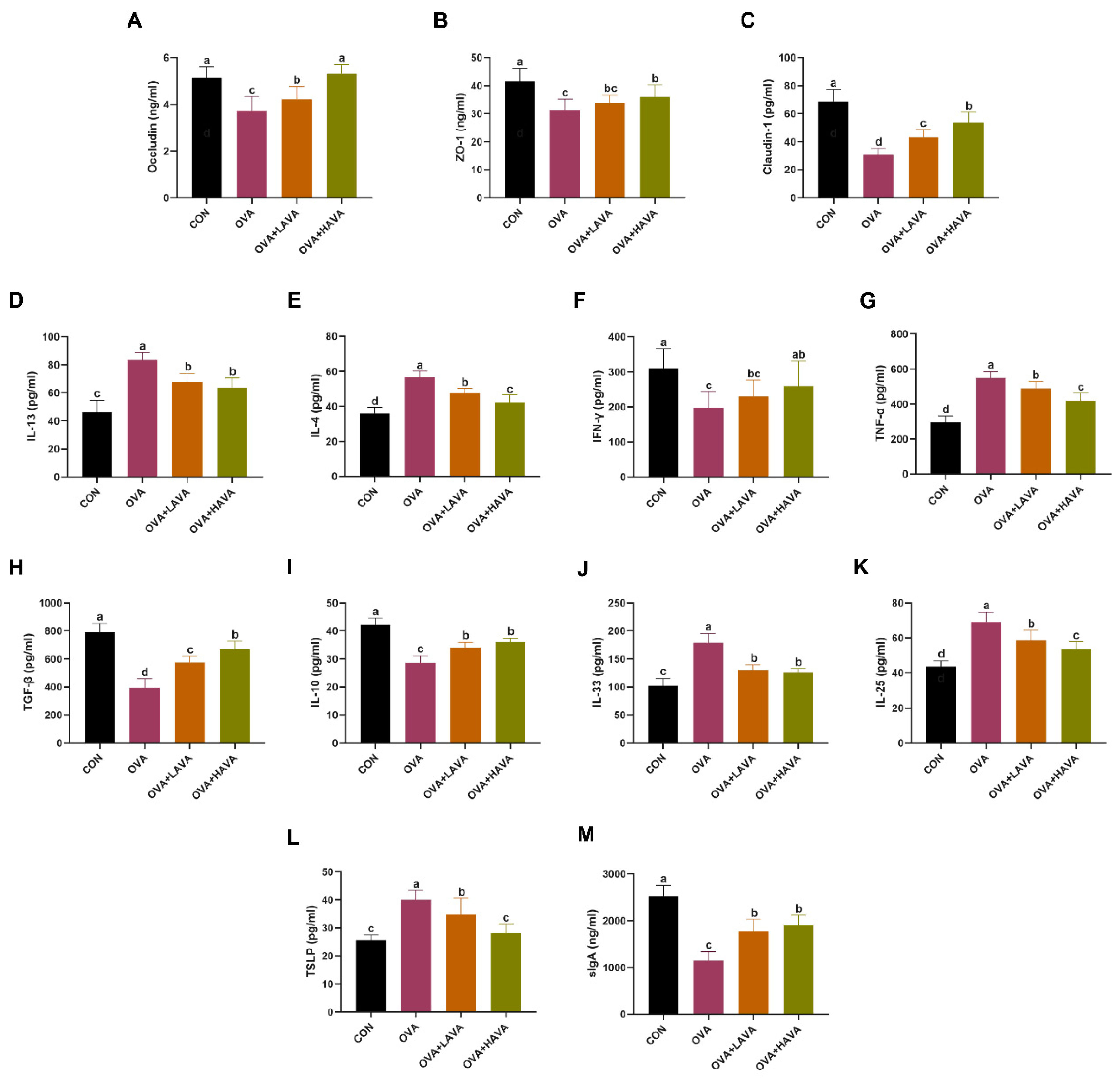
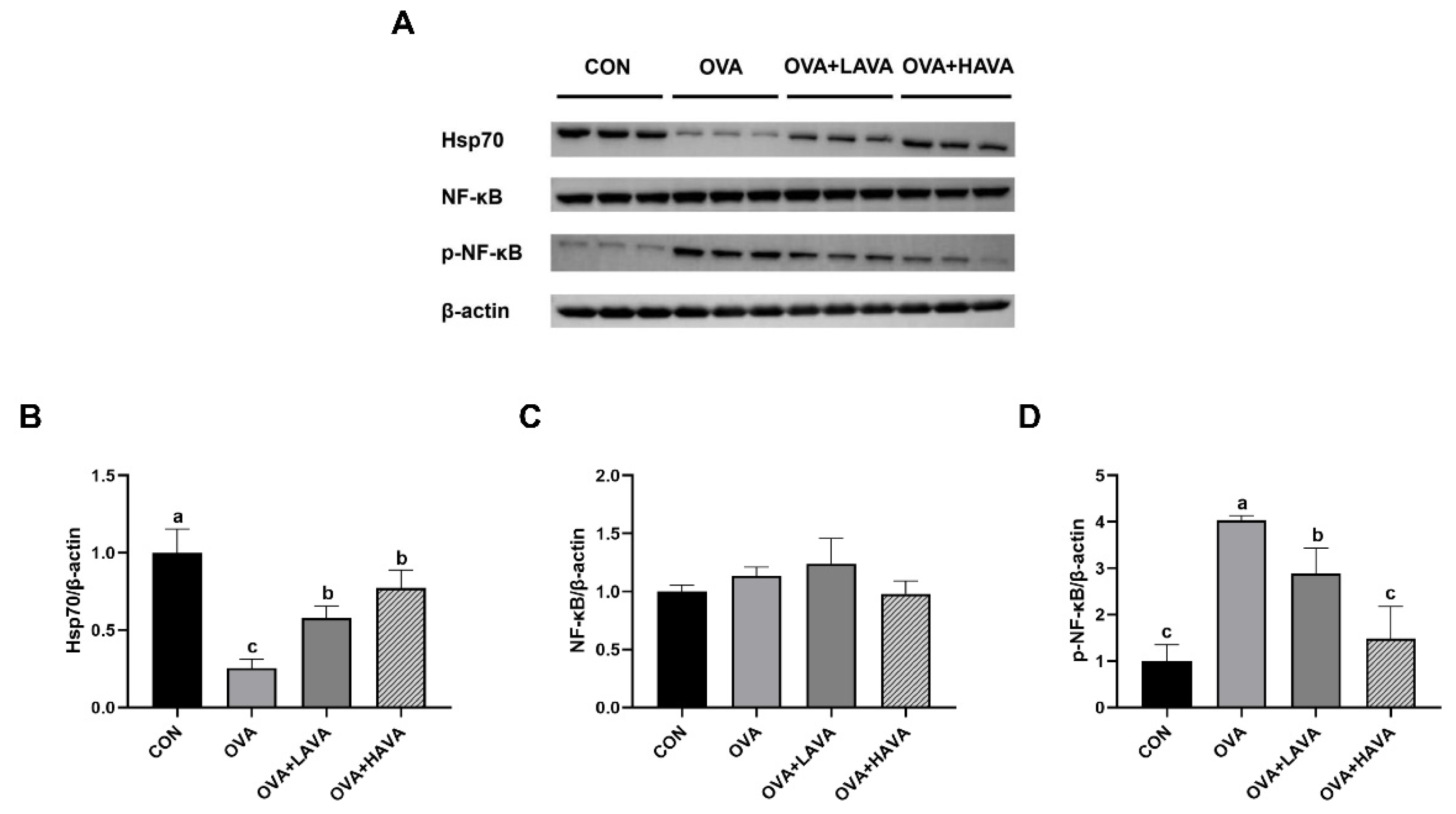
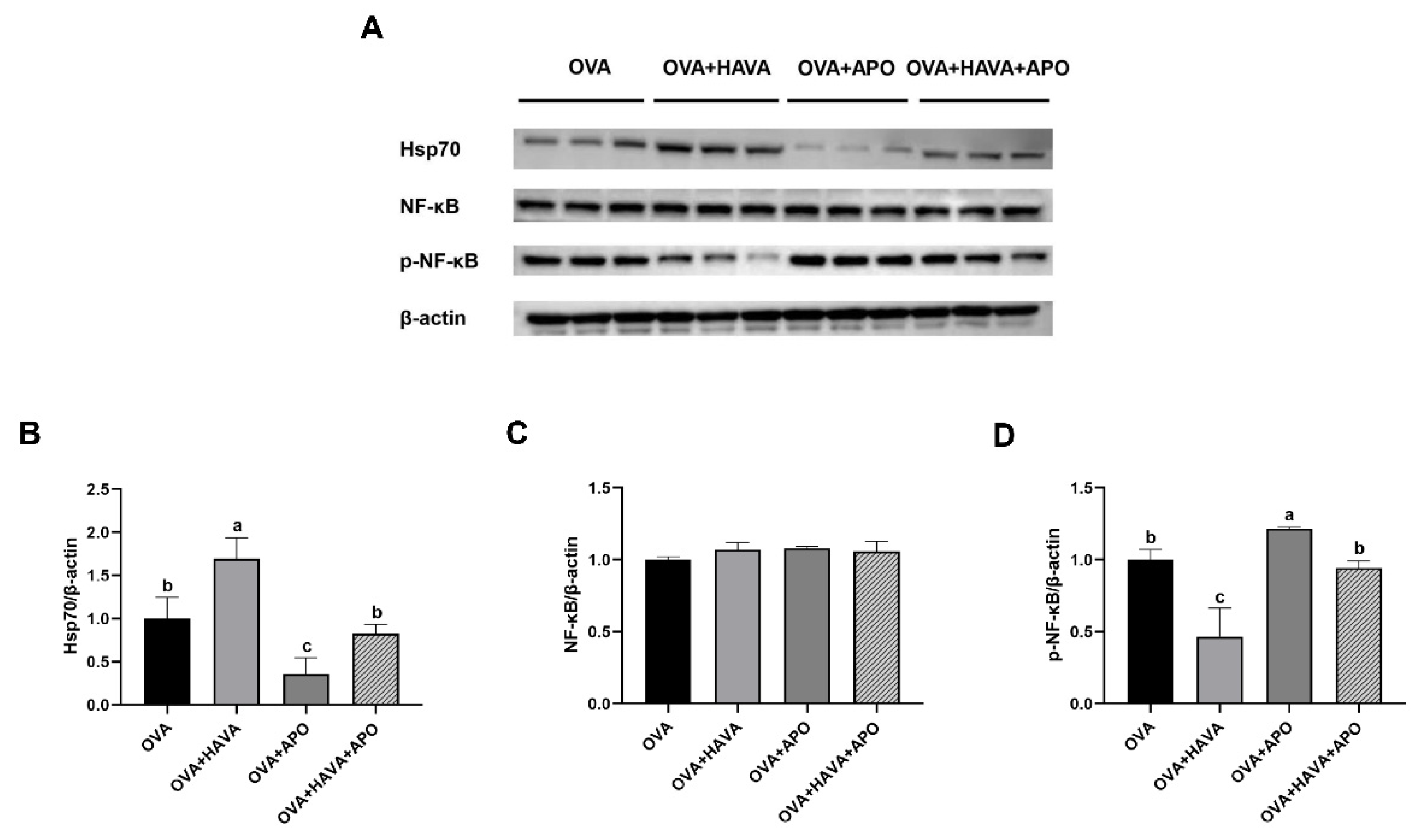
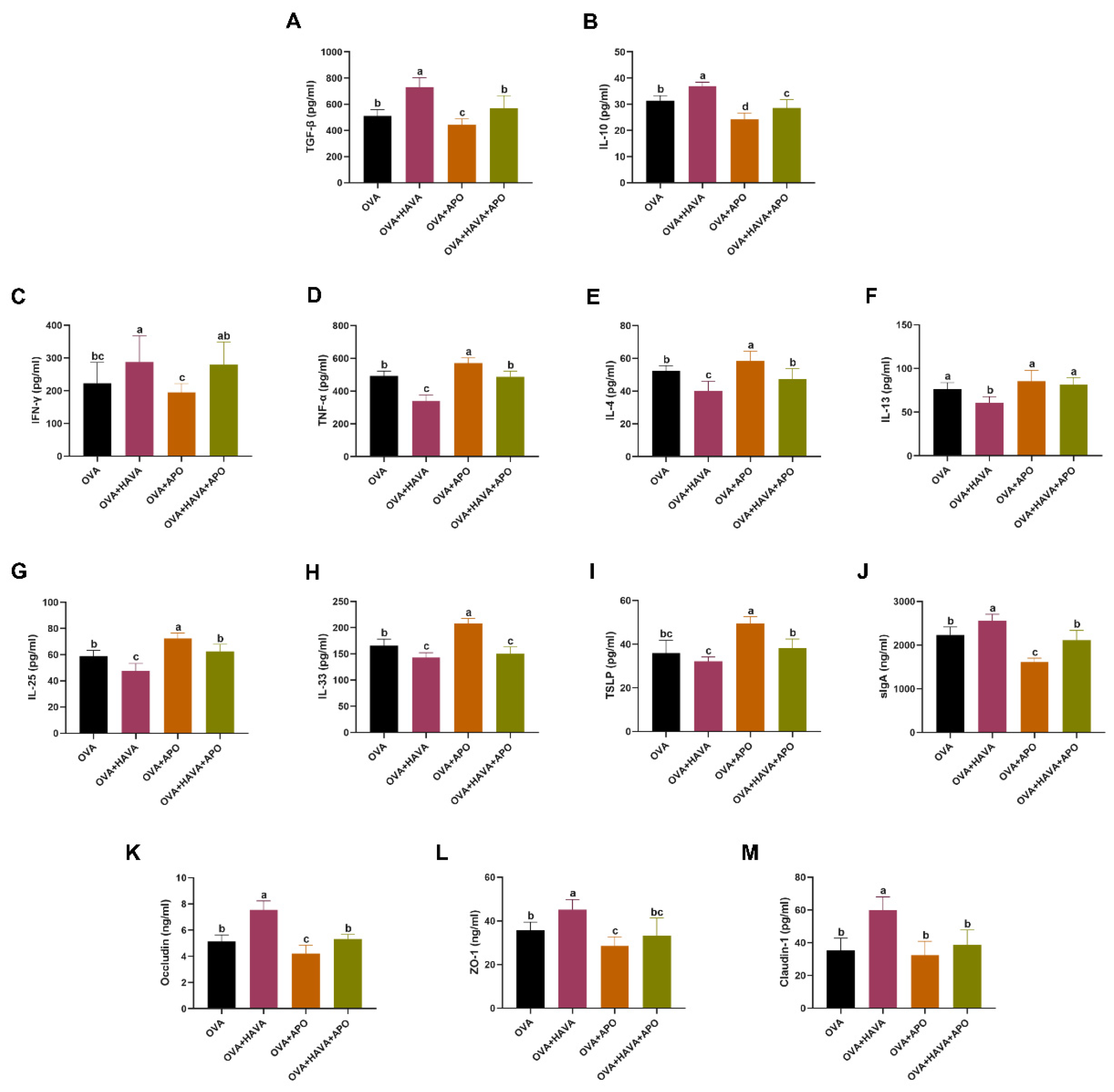
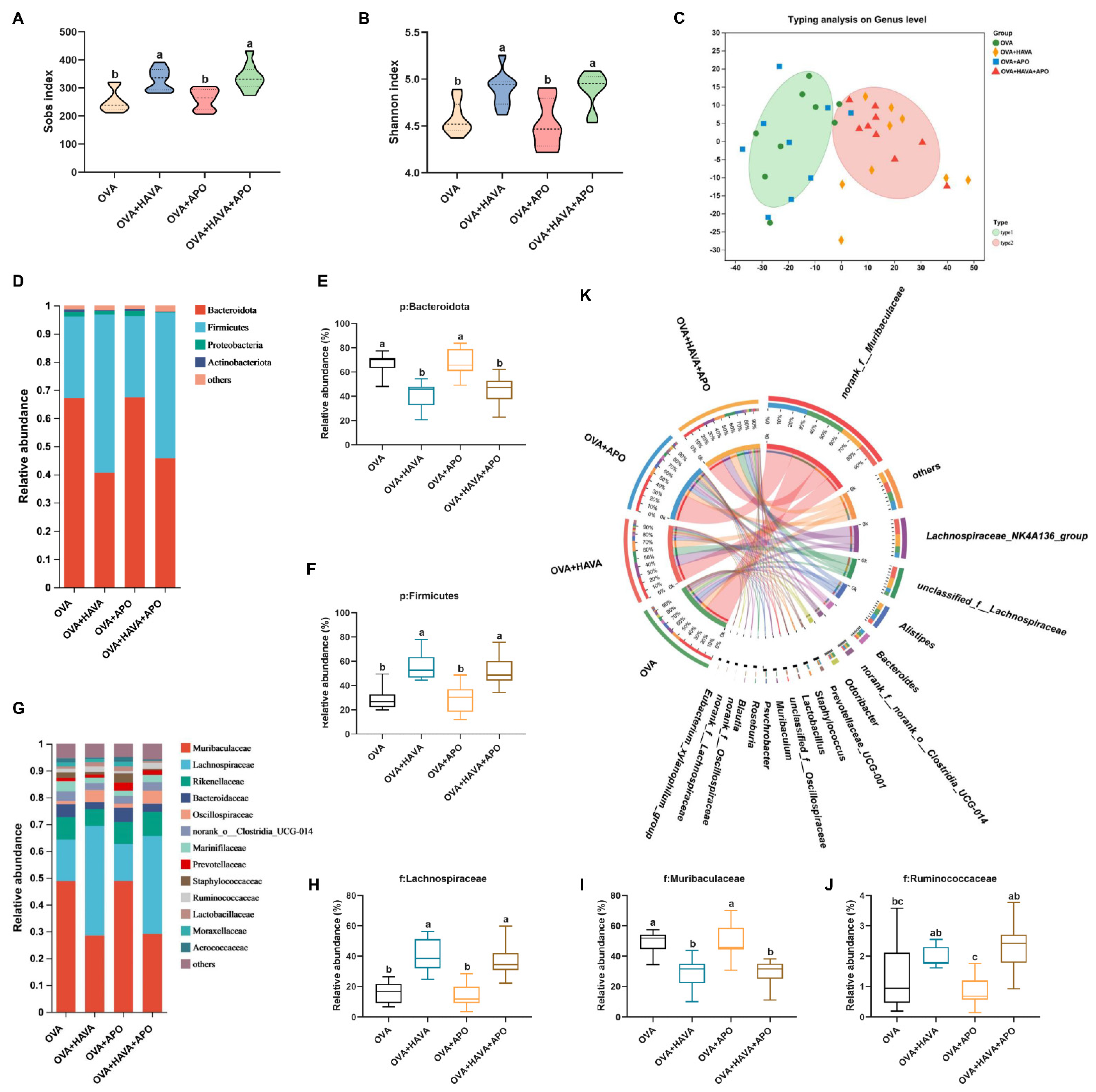
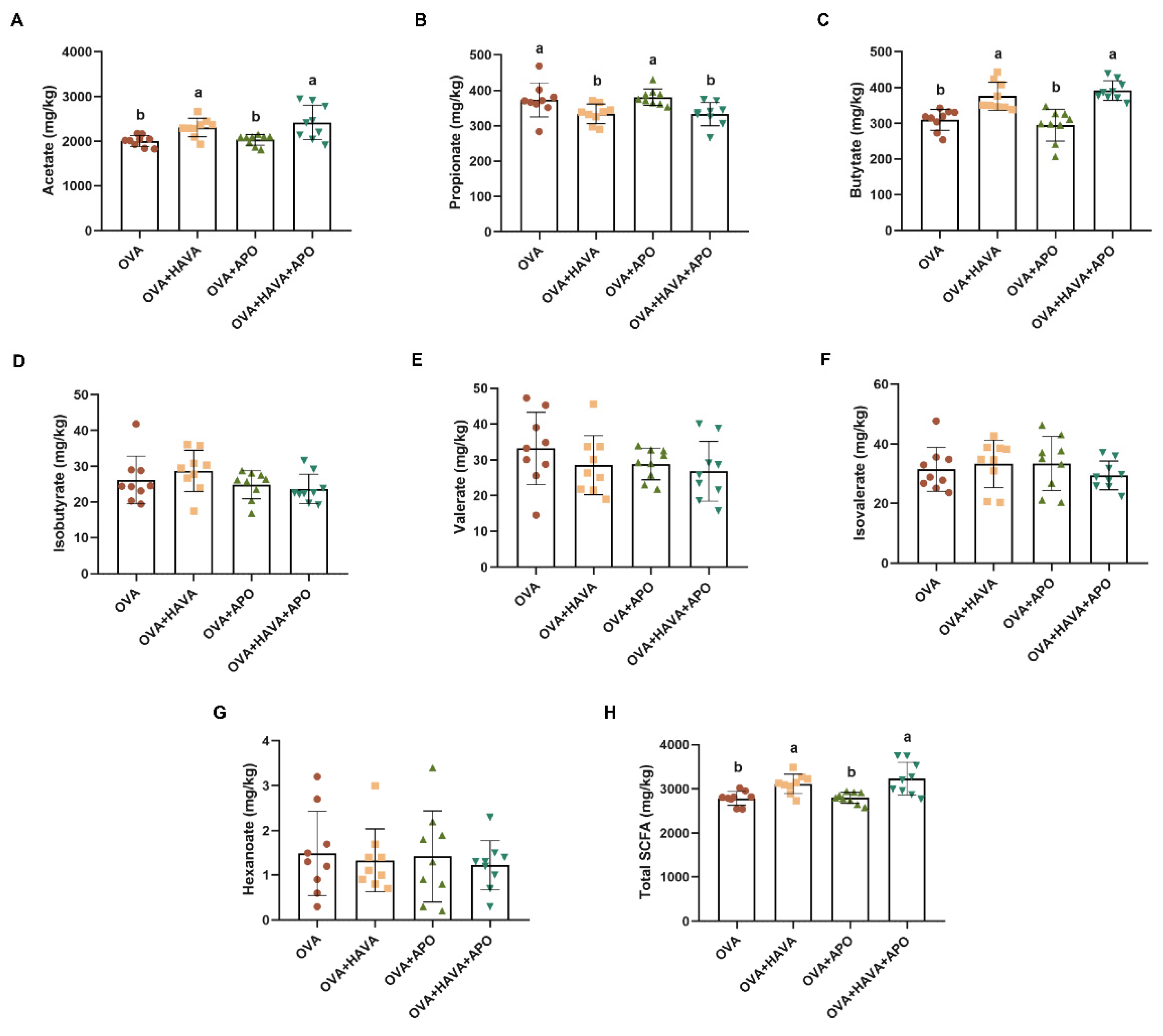
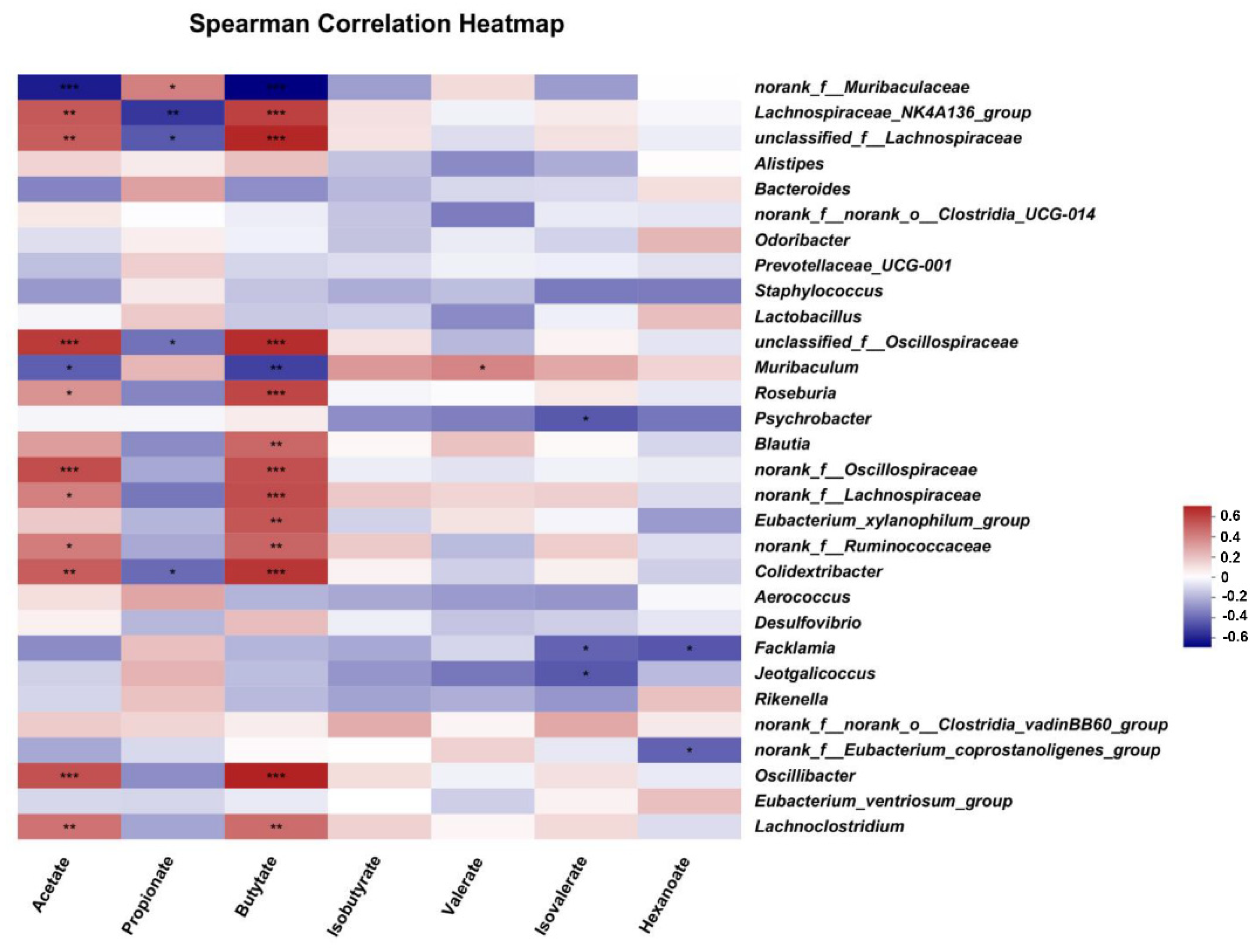
| Variable | OVA | OVA+HAVA | OVA+APO | OVA+HAVA +APO | p Value |
|---|---|---|---|---|---|
| Bacteroidota | 67.1 ± 8.41 a | 41.2 ± 11.0 b | 67.7 ± 11.2 a | 45.6 ± 11.7 b | <0.01 |
| Firmicutes | 28.9 ± 9.00 b | 55.5 ± 11.5 a | 28.7 ± 11.6 b | 51.8 ± 12.2 a | <0.01 |
| Desulfobacterota | 0.42 ± 0.26 | 0.89 ± 0.53 | 0.30 ± 0.30 | 0.72 ± 0.58 | 0.05 |
| Actinobacteriota | 1.03 ± 0.98 a | 0.26 ± 0.20 b | 0.78 ± 0.65 ab | 0.31 ± 0.19 ab | 0.02 |
| Muribaculaceae | 49.2 ± 7.22 a | 29.0 ± 9.87 b | 49.5 ± 12.4 a | 29.1 ± 8.18 b | <0.01 |
| Lachnospiraceae | 15.9 ± 6.95 b | 40.8 ± 11.00 a | 13.8 ± 7.63 b | 36.8 ± 10.9 a | <0.01 |
| Bacteroidaceae | 4.62 ± 2.64 ab | 2.59 ± 1.37 b | 5.21 ± 2.37 a | 3.06 ± 1.28 ab | 0.04 |
| Oscillospiraceae | 1.13 ± 0.63 b | 4.39 ± 3.24 a | 1.50 ± 0.83 b | 4.87 ± 2.58 a | <0.01 |
| Ruminococcaceae | 1.29 ± 1.11 bc | 1.99 ± 0.34 ab | 0.86 ± 0.49 c | 2.32 ± 0.79 ab | <0.01 |
| Desulfovibrionaceae | 0.42 ± 0.26 b | 0.89 ± 0.53 a | 0.30 ± 0.30 b | 0.72 ± 0.58 ab | 0.05 |
| Corynebacteriaceae | 0.59 ± 0.91 | 0.04 ± 0.02 | 0.53 ± 0.56 | 0.09 ± 0.12 | 0.09 |
| Peptococcaceae | 0.16 ± 0.09 b | 0.28 ± 0.16 ab | 0.18 ± 0.13 b | 0.43 ± 0.15 a | <0.01 |
| Anaerovoracaceae | 0.12 ± 0.09 ab | 0.14 ± 0.05 ab | 0.07 ± 0.05 b | 0.19 ± 0.07 a | <0.01 |
| Butyricicoccaceae | 0.04 ± 0.08 b | 0.17 ± 0.13 ab | 0.05 ± 0.06 b | 0.22 ± 0.15 a | <0.01 |
| norank_f__Muribaculaceae | 47.5 ± 7.21 a | 28.4 ± 9.56 b | 48.0 ± 11.7 a | 28.4 ± 7.93 b | <0.01 |
| Lachnospiraceae_NK4A136_group | 8.48 ± 4.47 bc | 19.0 ± 5.03 a | 5.84 ± 3.14 c | 15.0 ± 7.39 ab | <0.01 |
| unclassified_f_Lachnospiraceae | 4.62 ± 1.86 b | 14.5 ± 4.78 a | 4.91 ± 3.19 b | 13.7 ± 5.36 a | <0.01 |
| Bacteroides | 4.62 ± 2.64 ab | 2.59 ± 1.37 b | 5.21 ± 2.37 a | 3.06 ± 1.28 ab | 0.05 |
| unclassified_f_Oscillospiraceae | 0.58 ± 0.34 b | 1.56 ± 0.70 a | 0.75 ± 0.37 b | 1.52 ± 0.50 a | <0.01 |
| Muribaculum | 1.69 ± 0.80 a | 0.63 ± 0.58 b | 1.43 ± 1.24 ab | 0.63 ± 0.42 b | 0.01 |
| Roseburia | 0.31 ± 0.32 d | 1.37 ± 0.86 bc | 0.54 ± 0.62 cd | 1.77 ± 0.86 ab | <0.01 |
| Blautia | 0.44 ± 0.28 b | 1.14 ± 0.59 a | 0.56 ± 0.52 ab | 1.70 ± 1.37 a | <0.01 |
| norank_f_Oscillospiraceae | 0.20 ± 0.17 b | 1.18 ± 1.53 ab | 0.30 ± 0.21 b | 1.38 ± 1.22 a | <0.01 |
| norank_f_Lachnospiraceae | 0.26 ± 0.29 b | 1.45 ± 1.46 a | 0.18 ± 0.18 b | 0.97 ± 0.65 a | <0.01 |
| Eubacterium_xylanophilum_group | 0.33 ± 0.31 cd | 0.59 ± 0.53 bc | 0.53 ± 0.57 bc | 1.27 ± 0.75 ab | 0.02 |
| norank_f_Ruminococcaceae | 0.54 ± 0.64 ab | 0.68 ± 0.18 a | 0.24 ± 0.14 b | 0.76 ± 0.48 a | <0.01 |
| Colidextribacter | 0.15 ± 0.11 c | 0.75 ± 0.49 ab | 0.22 ± 0.17 bc | 0.98 ± 0.50 a | <0.01 |
| Rikenella | 0.57 ± 0.29 a | 0.27 ± 0.10 b | 0.51 ± 0.28 ab | 0.36 ± 0.18 ab | 0.01 |
| Lachnoclostridium | 0.25 ± 0.11 ab | 0.47 ± 0.27 ab | 0.20 ± 0.12 b | 0.49 ± 0.23 a | 0.01 |
| Oscillibacter | 0.08 ± 0.09 b | 0.56 ± 0.49 a | 0.10 ± 0.10 b | 0.65 ± 0.54 a | <0.01 |
Disclaimer/Publisher’s Note: The statements, opinions and data contained in all publications are solely those of the individual author(s) and contributor(s) and not of MDPI and/or the editor(s). MDPI and/or the editor(s) disclaim responsibility for any injury to people or property resulting from any ideas, methods, instructions or products referred to in the content. |
© 2023 by the authors. Licensee MDPI, Basel, Switzerland. This article is an open access article distributed under the terms and conditions of the Creative Commons Attribution (CC BY) license (https://creativecommons.org/licenses/by/4.0/).
Share and Cite
Liu, P.; Zhang, M.; Liu, T.; Mo, R.; Wang, H.; Zhang, G.; Wu, Y. Avenanthramide Improves Colonic Damage Induced by Food Allergies in Mice through Altering Gut Microbiota and Regulating Hsp70-NF-κB Signaling. Nutrients 2023, 15, 992. https://doi.org/10.3390/nu15040992
Liu P, Zhang M, Liu T, Mo R, Wang H, Zhang G, Wu Y. Avenanthramide Improves Colonic Damage Induced by Food Allergies in Mice through Altering Gut Microbiota and Regulating Hsp70-NF-κB Signaling. Nutrients. 2023; 15(4):992. https://doi.org/10.3390/nu15040992
Chicago/Turabian StyleLiu, Pan, Mingrui Zhang, Tianyi Liu, Ruixia Mo, Haotian Wang, Gang Zhang, and Yi Wu. 2023. "Avenanthramide Improves Colonic Damage Induced by Food Allergies in Mice through Altering Gut Microbiota and Regulating Hsp70-NF-κB Signaling" Nutrients 15, no. 4: 992. https://doi.org/10.3390/nu15040992
APA StyleLiu, P., Zhang, M., Liu, T., Mo, R., Wang, H., Zhang, G., & Wu, Y. (2023). Avenanthramide Improves Colonic Damage Induced by Food Allergies in Mice through Altering Gut Microbiota and Regulating Hsp70-NF-κB Signaling. Nutrients, 15(4), 992. https://doi.org/10.3390/nu15040992







